Research Project on Countries' GDP and Birthrates Relationship
VerifiedAdded on 2020/04/15
|15
|2715
|76
Project
AI Summary
This research proposal investigates the relationship between a country's Gross Domestic Product (GDP) and its birthrates. It outlines the project's objectives, scope, and research questions, including a primary question on the relationship between GDP and birthrates and secondary questions exploring the reasons behind the inverse relationship and the implications of fertility trends. The proposal includes a literature review discussing existing theories and empirical evidence, identifying gaps and opportunities for further research. The methodology section details the qualitative research approach, deductive reasoning, and data collection methods, including thematic analysis of secondary sources. The research design addresses reliability, validity, sampling, and potential limitations, followed by a time schedule for the project's completion. The conclusion summarizes the key aspects of the research and the researcher's findings.
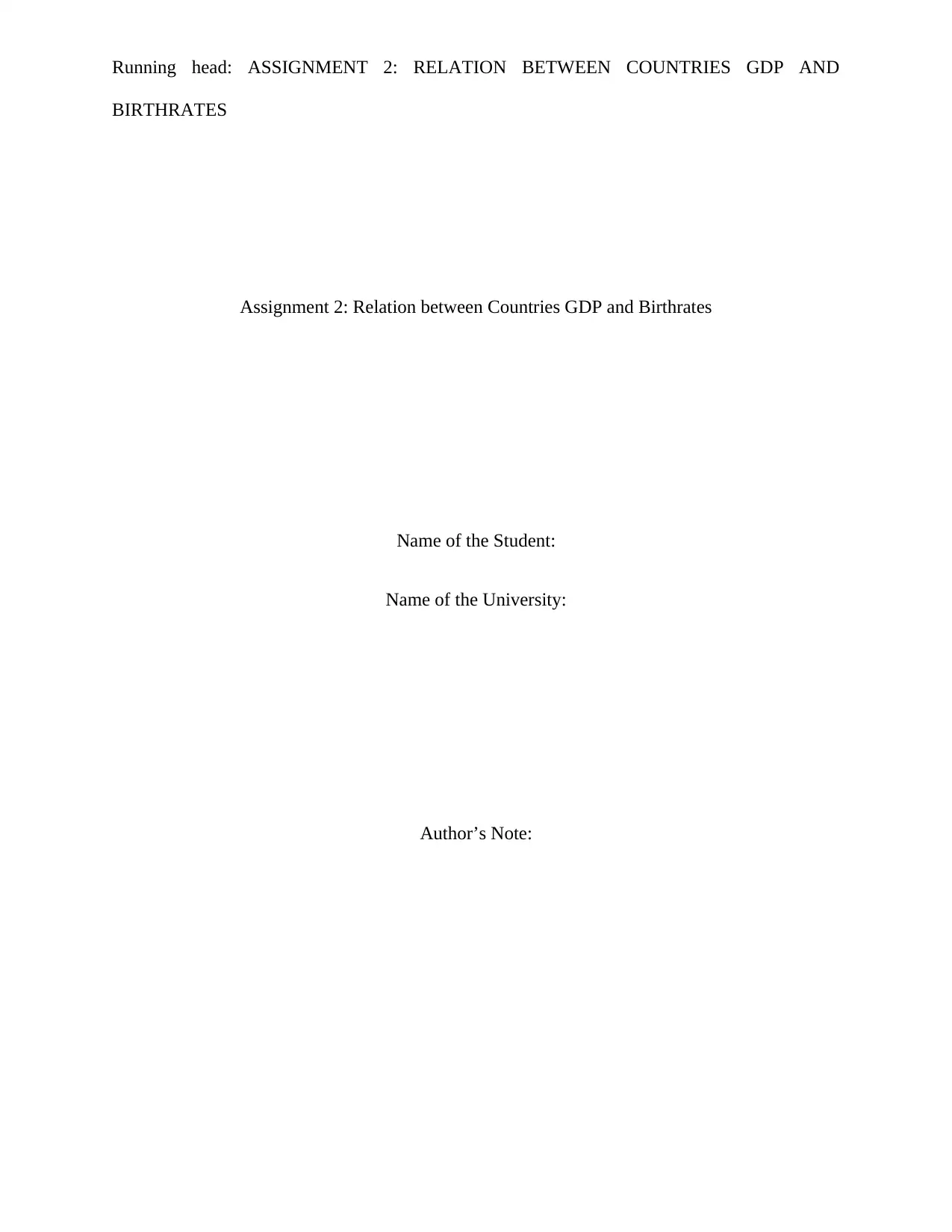
Running head: ASSIGNMENT 2: RELATION BETWEEN COUNTRIES GDP AND
BIRTHRATES
Assignment 2: Relation between Countries GDP and Birthrates
Name of the Student:
Name of the University:
Author’s Note:
BIRTHRATES
Assignment 2: Relation between Countries GDP and Birthrates
Name of the Student:
Name of the University:
Author’s Note:
Paraphrase This Document
Need a fresh take? Get an instant paraphrase of this document with our AI Paraphraser
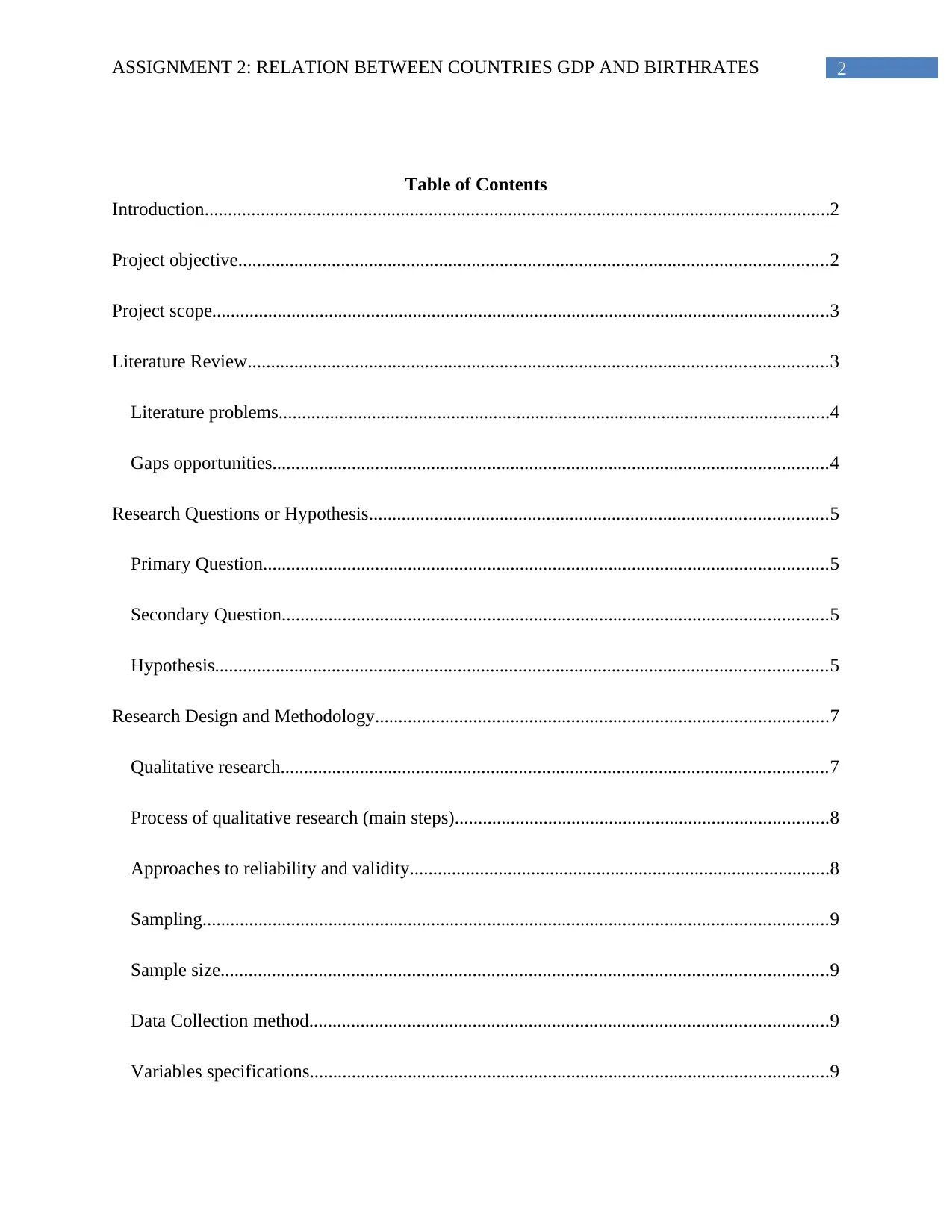
2ASSIGNMENT 2: RELATION BETWEEN COUNTRIES GDP AND BIRTHRATES
Table of Contents
Introduction......................................................................................................................................2
Project objective..............................................................................................................................2
Project scope....................................................................................................................................3
Literature Review............................................................................................................................3
Literature problems......................................................................................................................4
Gaps opportunities.......................................................................................................................4
Research Questions or Hypothesis..................................................................................................5
Primary Question.........................................................................................................................5
Secondary Question.....................................................................................................................5
Hypothesis...................................................................................................................................5
Research Design and Methodology.................................................................................................7
Qualitative research.....................................................................................................................7
Process of qualitative research (main steps)................................................................................8
Approaches to reliability and validity..........................................................................................8
Sampling......................................................................................................................................9
Sample size..................................................................................................................................9
Data Collection method...............................................................................................................9
Variables specifications...............................................................................................................9
Table of Contents
Introduction......................................................................................................................................2
Project objective..............................................................................................................................2
Project scope....................................................................................................................................3
Literature Review............................................................................................................................3
Literature problems......................................................................................................................4
Gaps opportunities.......................................................................................................................4
Research Questions or Hypothesis..................................................................................................5
Primary Question.........................................................................................................................5
Secondary Question.....................................................................................................................5
Hypothesis...................................................................................................................................5
Research Design and Methodology.................................................................................................7
Qualitative research.....................................................................................................................7
Process of qualitative research (main steps)................................................................................8
Approaches to reliability and validity..........................................................................................8
Sampling......................................................................................................................................9
Sample size..................................................................................................................................9
Data Collection method...............................................................................................................9
Variables specifications...............................................................................................................9
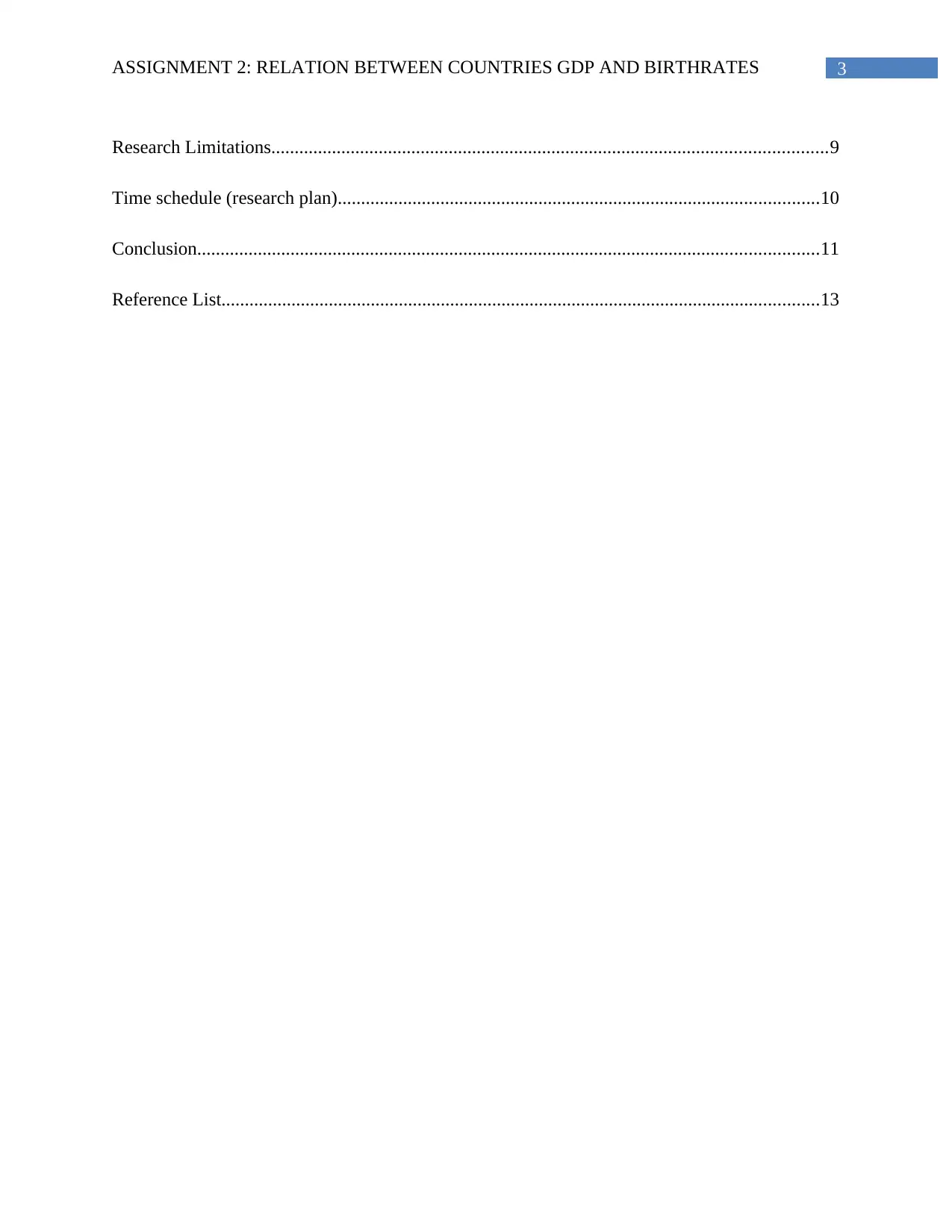
3ASSIGNMENT 2: RELATION BETWEEN COUNTRIES GDP AND BIRTHRATES
Research Limitations.......................................................................................................................9
Time schedule (research plan).......................................................................................................10
Conclusion.....................................................................................................................................11
Reference List................................................................................................................................13
Research Limitations.......................................................................................................................9
Time schedule (research plan).......................................................................................................10
Conclusion.....................................................................................................................................11
Reference List................................................................................................................................13
⊘ This is a preview!⊘
Do you want full access?
Subscribe today to unlock all pages.

Trusted by 1+ million students worldwide
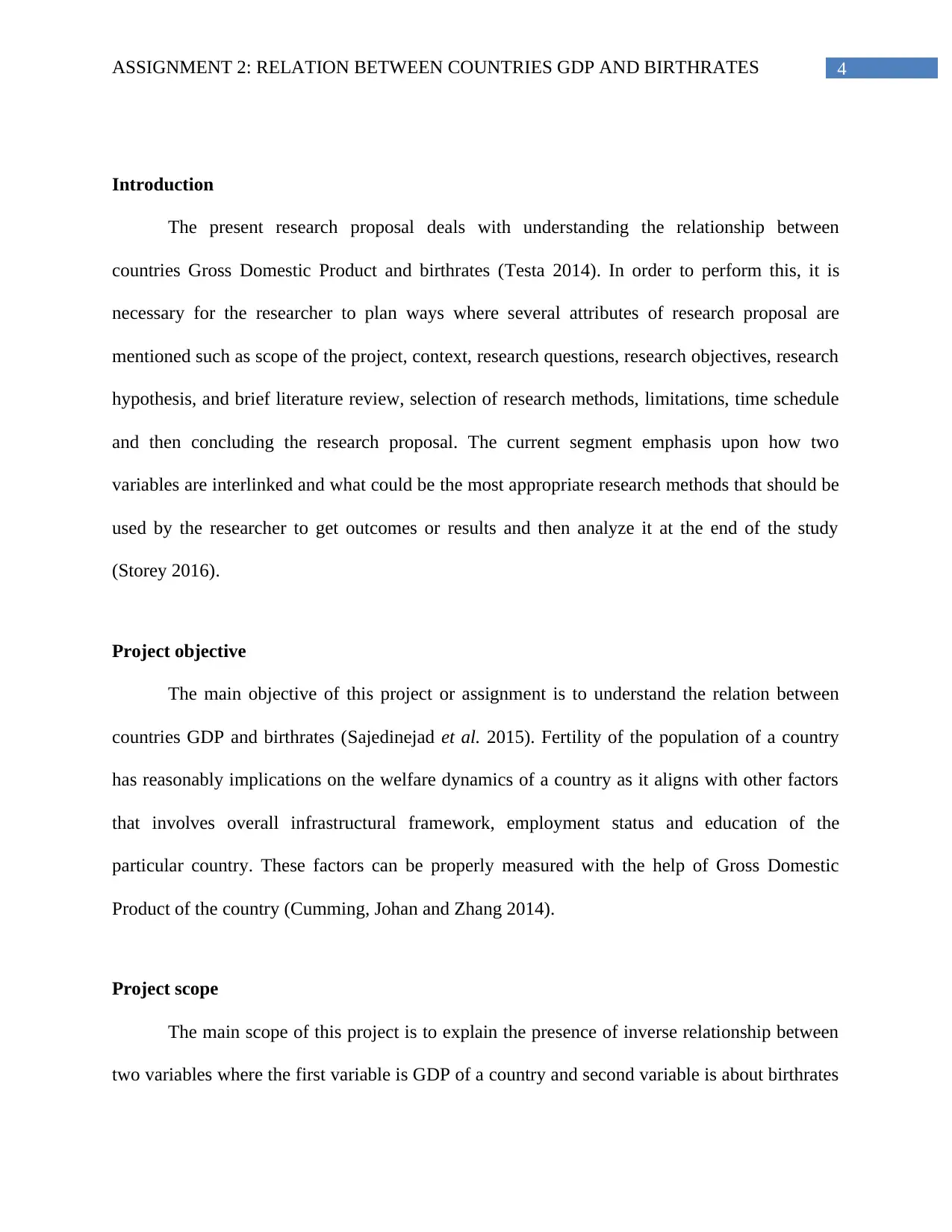
4ASSIGNMENT 2: RELATION BETWEEN COUNTRIES GDP AND BIRTHRATES
Introduction
The present research proposal deals with understanding the relationship between
countries Gross Domestic Product and birthrates (Testa 2014). In order to perform this, it is
necessary for the researcher to plan ways where several attributes of research proposal are
mentioned such as scope of the project, context, research questions, research objectives, research
hypothesis, and brief literature review, selection of research methods, limitations, time schedule
and then concluding the research proposal. The current segment emphasis upon how two
variables are interlinked and what could be the most appropriate research methods that should be
used by the researcher to get outcomes or results and then analyze it at the end of the study
(Storey 2016).
Project objective
The main objective of this project or assignment is to understand the relation between
countries GDP and birthrates (Sajedinejad et al. 2015). Fertility of the population of a country
has reasonably implications on the welfare dynamics of a country as it aligns with other factors
that involves overall infrastructural framework, employment status and education of the
particular country. These factors can be properly measured with the help of Gross Domestic
Product of the country (Cumming, Johan and Zhang 2014).
Project scope
The main scope of this project is to explain the presence of inverse relationship between
two variables where the first variable is GDP of a country and second variable is about birthrates
Introduction
The present research proposal deals with understanding the relationship between
countries Gross Domestic Product and birthrates (Testa 2014). In order to perform this, it is
necessary for the researcher to plan ways where several attributes of research proposal are
mentioned such as scope of the project, context, research questions, research objectives, research
hypothesis, and brief literature review, selection of research methods, limitations, time schedule
and then concluding the research proposal. The current segment emphasis upon how two
variables are interlinked and what could be the most appropriate research methods that should be
used by the researcher to get outcomes or results and then analyze it at the end of the study
(Storey 2016).
Project objective
The main objective of this project or assignment is to understand the relation between
countries GDP and birthrates (Sajedinejad et al. 2015). Fertility of the population of a country
has reasonably implications on the welfare dynamics of a country as it aligns with other factors
that involves overall infrastructural framework, employment status and education of the
particular country. These factors can be properly measured with the help of Gross Domestic
Product of the country (Cumming, Johan and Zhang 2014).
Project scope
The main scope of this project is to explain the presence of inverse relationship between
two variables where the first variable is GDP of a country and second variable is about birthrates
Paraphrase This Document
Need a fresh take? Get an instant paraphrase of this document with our AI Paraphraser
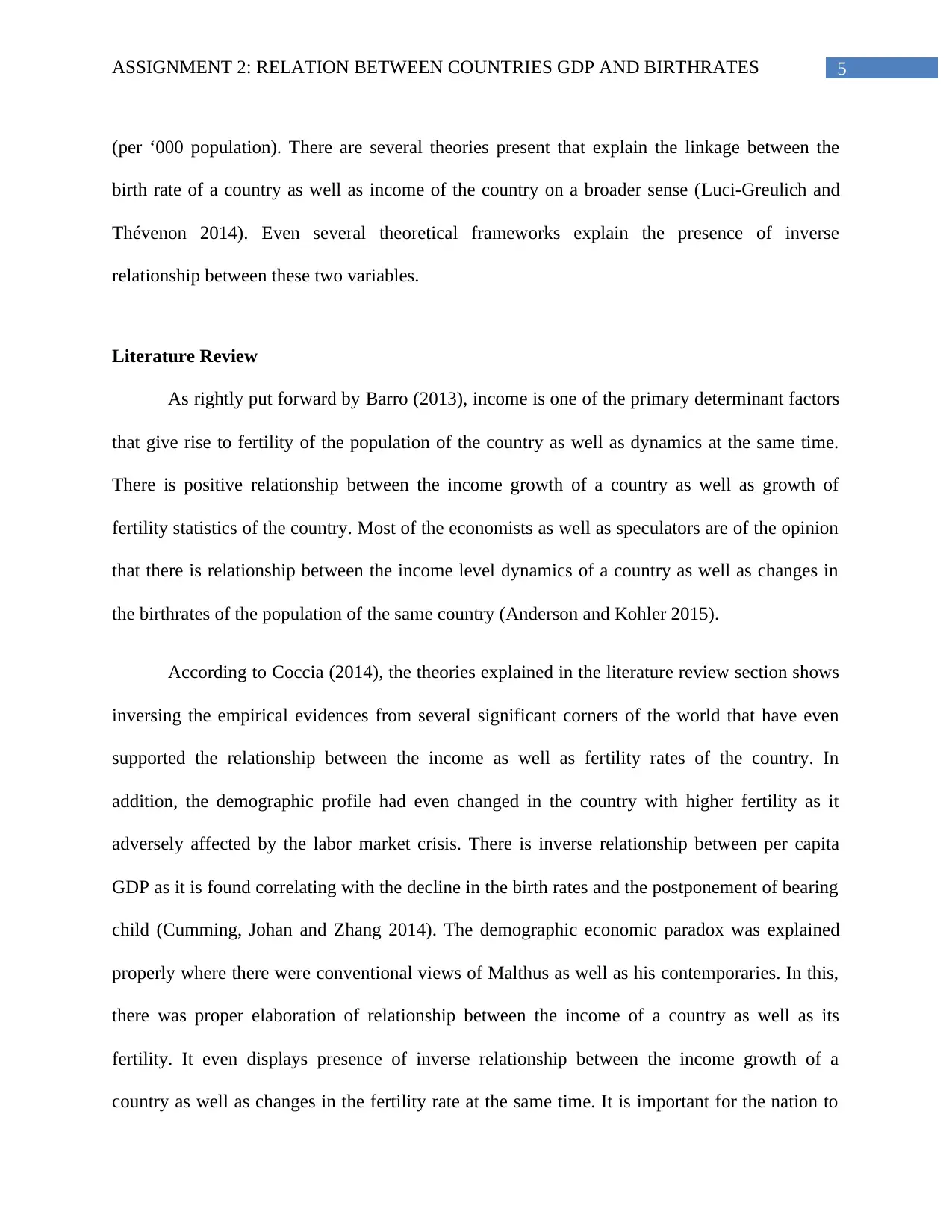
5ASSIGNMENT 2: RELATION BETWEEN COUNTRIES GDP AND BIRTHRATES
(per ‘000 population). There are several theories present that explain the linkage between the
birth rate of a country as well as income of the country on a broader sense (Luci-Greulich and
Thévenon 2014). Even several theoretical frameworks explain the presence of inverse
relationship between these two variables.
Literature Review
As rightly put forward by Barro (2013), income is one of the primary determinant factors
that give rise to fertility of the population of the country as well as dynamics at the same time.
There is positive relationship between the income growth of a country as well as growth of
fertility statistics of the country. Most of the economists as well as speculators are of the opinion
that there is relationship between the income level dynamics of a country as well as changes in
the birthrates of the population of the same country (Anderson and Kohler 2015).
According to Coccia (2014), the theories explained in the literature review section shows
inversing the empirical evidences from several significant corners of the world that have even
supported the relationship between the income as well as fertility rates of the country. In
addition, the demographic profile had even changed in the country with higher fertility as it
adversely affected by the labor market crisis. There is inverse relationship between per capita
GDP as it is found correlating with the decline in the birth rates and the postponement of bearing
child (Cumming, Johan and Zhang 2014). The demographic economic paradox was explained
properly where there were conventional views of Malthus as well as his contemporaries. In this,
there was proper elaboration of relationship between the income of a country as well as its
fertility. It even displays presence of inverse relationship between the income growth of a
country as well as changes in the fertility rate at the same time. It is important for the nation to
(per ‘000 population). There are several theories present that explain the linkage between the
birth rate of a country as well as income of the country on a broader sense (Luci-Greulich and
Thévenon 2014). Even several theoretical frameworks explain the presence of inverse
relationship between these two variables.
Literature Review
As rightly put forward by Barro (2013), income is one of the primary determinant factors
that give rise to fertility of the population of the country as well as dynamics at the same time.
There is positive relationship between the income growth of a country as well as growth of
fertility statistics of the country. Most of the economists as well as speculators are of the opinion
that there is relationship between the income level dynamics of a country as well as changes in
the birthrates of the population of the same country (Anderson and Kohler 2015).
According to Coccia (2014), the theories explained in the literature review section shows
inversing the empirical evidences from several significant corners of the world that have even
supported the relationship between the income as well as fertility rates of the country. In
addition, the demographic profile had even changed in the country with higher fertility as it
adversely affected by the labor market crisis. There is inverse relationship between per capita
GDP as it is found correlating with the decline in the birth rates and the postponement of bearing
child (Cumming, Johan and Zhang 2014). The demographic economic paradox was explained
properly where there were conventional views of Malthus as well as his contemporaries. In this,
there was proper elaboration of relationship between the income of a country as well as its
fertility. It even displays presence of inverse relationship between the income growth of a
country as well as changes in the fertility rate at the same time. It is important for the nation to
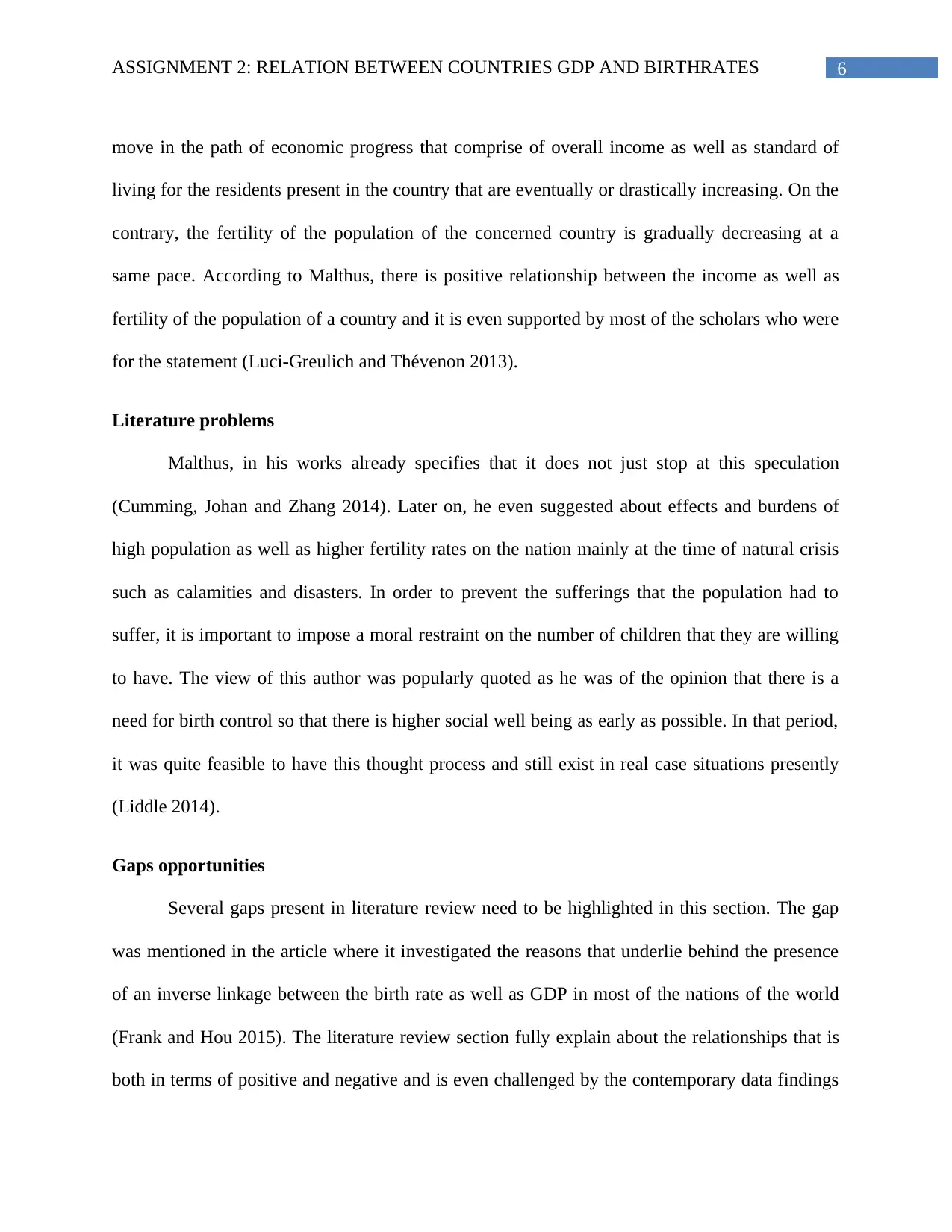
6ASSIGNMENT 2: RELATION BETWEEN COUNTRIES GDP AND BIRTHRATES
move in the path of economic progress that comprise of overall income as well as standard of
living for the residents present in the country that are eventually or drastically increasing. On the
contrary, the fertility of the population of the concerned country is gradually decreasing at a
same pace. According to Malthus, there is positive relationship between the income as well as
fertility of the population of a country and it is even supported by most of the scholars who were
for the statement (Luci-Greulich and Thévenon 2013).
Literature problems
Malthus, in his works already specifies that it does not just stop at this speculation
(Cumming, Johan and Zhang 2014). Later on, he even suggested about effects and burdens of
high population as well as higher fertility rates on the nation mainly at the time of natural crisis
such as calamities and disasters. In order to prevent the sufferings that the population had to
suffer, it is important to impose a moral restraint on the number of children that they are willing
to have. The view of this author was popularly quoted as he was of the opinion that there is a
need for birth control so that there is higher social well being as early as possible. In that period,
it was quite feasible to have this thought process and still exist in real case situations presently
(Liddle 2014).
Gaps opportunities
Several gaps present in literature review need to be highlighted in this section. The gap
was mentioned in the article where it investigated the reasons that underlie behind the presence
of an inverse linkage between the birth rate as well as GDP in most of the nations of the world
(Frank and Hou 2015). The literature review section fully explain about the relationships that is
both in terms of positive and negative and is even challenged by the contemporary data findings
move in the path of economic progress that comprise of overall income as well as standard of
living for the residents present in the country that are eventually or drastically increasing. On the
contrary, the fertility of the population of the concerned country is gradually decreasing at a
same pace. According to Malthus, there is positive relationship between the income as well as
fertility of the population of a country and it is even supported by most of the scholars who were
for the statement (Luci-Greulich and Thévenon 2013).
Literature problems
Malthus, in his works already specifies that it does not just stop at this speculation
(Cumming, Johan and Zhang 2014). Later on, he even suggested about effects and burdens of
high population as well as higher fertility rates on the nation mainly at the time of natural crisis
such as calamities and disasters. In order to prevent the sufferings that the population had to
suffer, it is important to impose a moral restraint on the number of children that they are willing
to have. The view of this author was popularly quoted as he was of the opinion that there is a
need for birth control so that there is higher social well being as early as possible. In that period,
it was quite feasible to have this thought process and still exist in real case situations presently
(Liddle 2014).
Gaps opportunities
Several gaps present in literature review need to be highlighted in this section. The gap
was mentioned in the article where it investigated the reasons that underlie behind the presence
of an inverse linkage between the birth rate as well as GDP in most of the nations of the world
(Frank and Hou 2015). The literature review section fully explain about the relationships that is
both in terms of positive and negative and is even challenged by the contemporary data findings
⊘ This is a preview!⊘
Do you want full access?
Subscribe today to unlock all pages.

Trusted by 1+ million students worldwide
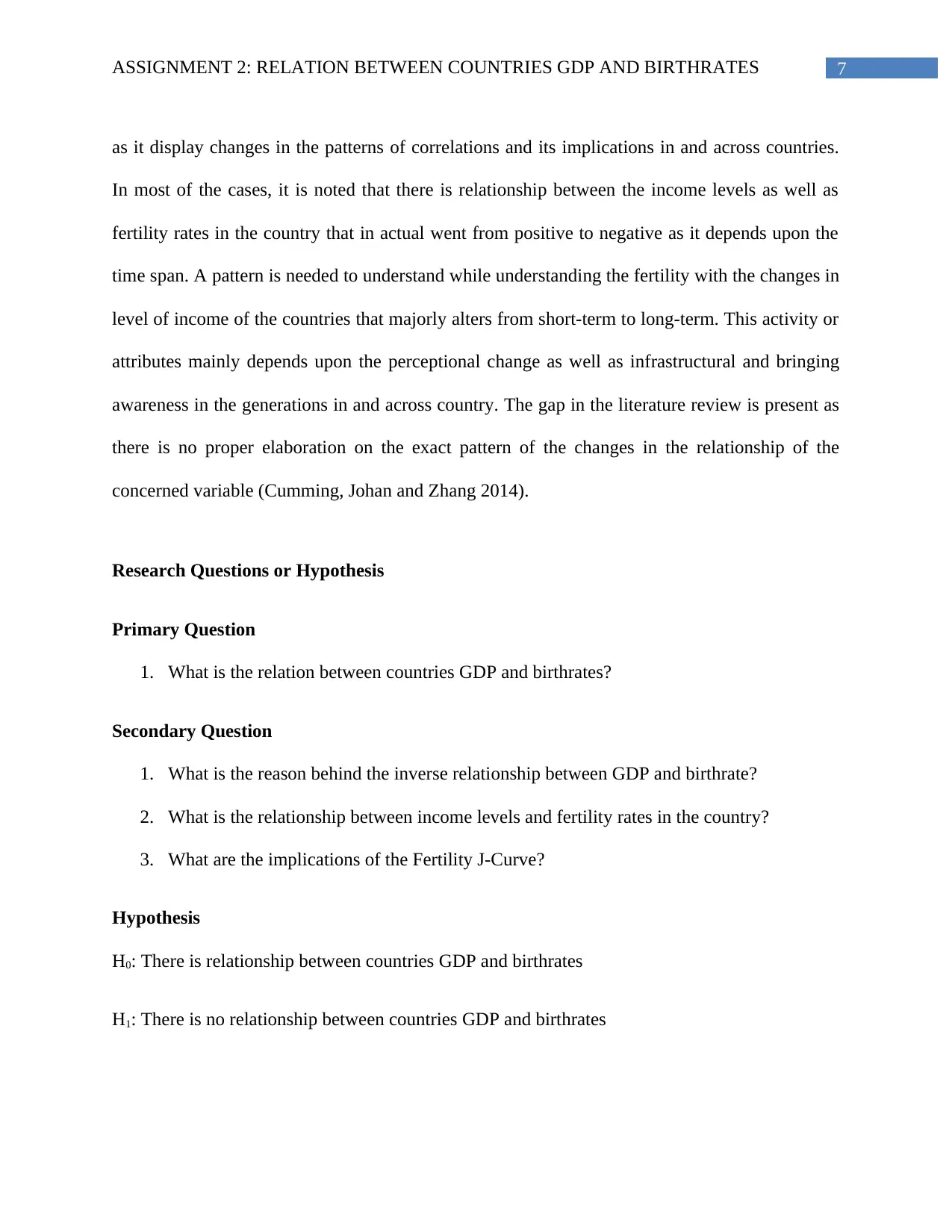
7ASSIGNMENT 2: RELATION BETWEEN COUNTRIES GDP AND BIRTHRATES
as it display changes in the patterns of correlations and its implications in and across countries.
In most of the cases, it is noted that there is relationship between the income levels as well as
fertility rates in the country that in actual went from positive to negative as it depends upon the
time span. A pattern is needed to understand while understanding the fertility with the changes in
level of income of the countries that majorly alters from short-term to long-term. This activity or
attributes mainly depends upon the perceptional change as well as infrastructural and bringing
awareness in the generations in and across country. The gap in the literature review is present as
there is no proper elaboration on the exact pattern of the changes in the relationship of the
concerned variable (Cumming, Johan and Zhang 2014).
Research Questions or Hypothesis
Primary Question
1. What is the relation between countries GDP and birthrates?
Secondary Question
1. What is the reason behind the inverse relationship between GDP and birthrate?
2. What is the relationship between income levels and fertility rates in the country?
3. What are the implications of the Fertility J-Curve?
Hypothesis
H0: There is relationship between countries GDP and birthrates
H1: There is no relationship between countries GDP and birthrates
as it display changes in the patterns of correlations and its implications in and across countries.
In most of the cases, it is noted that there is relationship between the income levels as well as
fertility rates in the country that in actual went from positive to negative as it depends upon the
time span. A pattern is needed to understand while understanding the fertility with the changes in
level of income of the countries that majorly alters from short-term to long-term. This activity or
attributes mainly depends upon the perceptional change as well as infrastructural and bringing
awareness in the generations in and across country. The gap in the literature review is present as
there is no proper elaboration on the exact pattern of the changes in the relationship of the
concerned variable (Cumming, Johan and Zhang 2014).
Research Questions or Hypothesis
Primary Question
1. What is the relation between countries GDP and birthrates?
Secondary Question
1. What is the reason behind the inverse relationship between GDP and birthrate?
2. What is the relationship between income levels and fertility rates in the country?
3. What are the implications of the Fertility J-Curve?
Hypothesis
H0: There is relationship between countries GDP and birthrates
H1: There is no relationship between countries GDP and birthrates
Paraphrase This Document
Need a fresh take? Get an instant paraphrase of this document with our AI Paraphraser
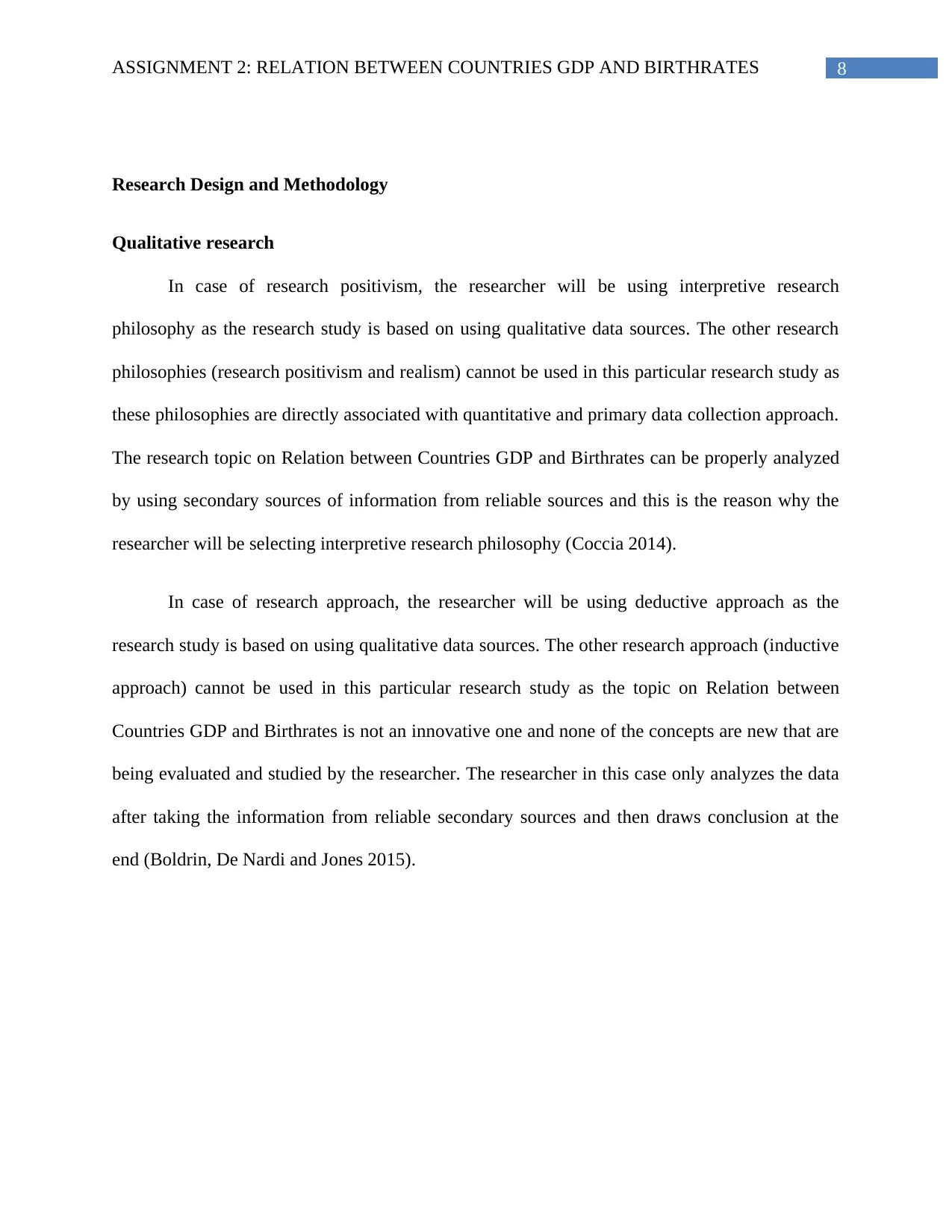
8ASSIGNMENT 2: RELATION BETWEEN COUNTRIES GDP AND BIRTHRATES
Research Design and Methodology
Qualitative research
In case of research positivism, the researcher will be using interpretive research
philosophy as the research study is based on using qualitative data sources. The other research
philosophies (research positivism and realism) cannot be used in this particular research study as
these philosophies are directly associated with quantitative and primary data collection approach.
The research topic on Relation between Countries GDP and Birthrates can be properly analyzed
by using secondary sources of information from reliable sources and this is the reason why the
researcher will be selecting interpretive research philosophy (Coccia 2014).
In case of research approach, the researcher will be using deductive approach as the
research study is based on using qualitative data sources. The other research approach (inductive
approach) cannot be used in this particular research study as the topic on Relation between
Countries GDP and Birthrates is not an innovative one and none of the concepts are new that are
being evaluated and studied by the researcher. The researcher in this case only analyzes the data
after taking the information from reliable secondary sources and then draws conclusion at the
end (Boldrin, De Nardi and Jones 2015).
Research Design and Methodology
Qualitative research
In case of research positivism, the researcher will be using interpretive research
philosophy as the research study is based on using qualitative data sources. The other research
philosophies (research positivism and realism) cannot be used in this particular research study as
these philosophies are directly associated with quantitative and primary data collection approach.
The research topic on Relation between Countries GDP and Birthrates can be properly analyzed
by using secondary sources of information from reliable sources and this is the reason why the
researcher will be selecting interpretive research philosophy (Coccia 2014).
In case of research approach, the researcher will be using deductive approach as the
research study is based on using qualitative data sources. The other research approach (inductive
approach) cannot be used in this particular research study as the topic on Relation between
Countries GDP and Birthrates is not an innovative one and none of the concepts are new that are
being evaluated and studied by the researcher. The researcher in this case only analyzes the data
after taking the information from reliable secondary sources and then draws conclusion at the
end (Boldrin, De Nardi and Jones 2015).
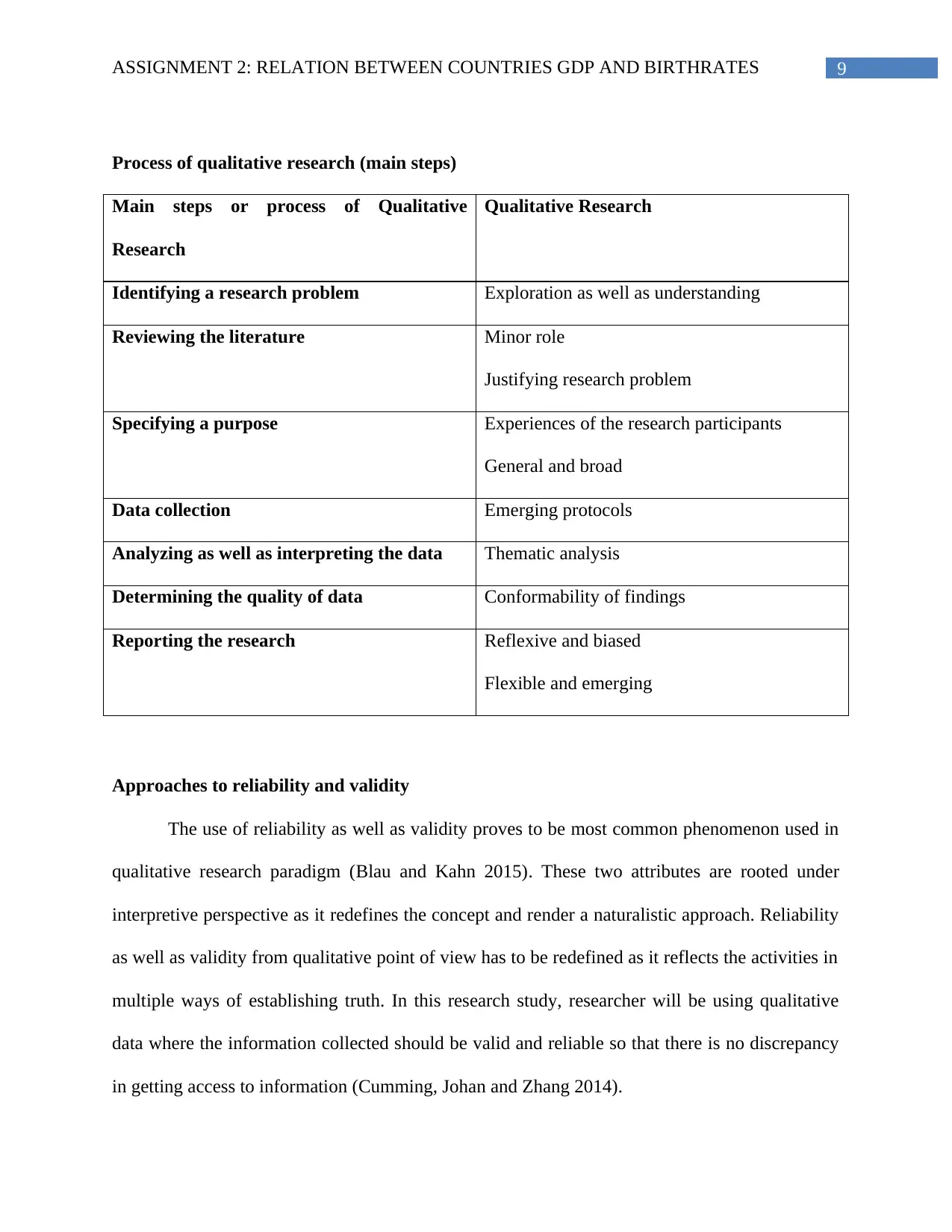
9ASSIGNMENT 2: RELATION BETWEEN COUNTRIES GDP AND BIRTHRATES
Process of qualitative research (main steps)
Main steps or process of Qualitative
Research
Qualitative Research
Identifying a research problem Exploration as well as understanding
Reviewing the literature Minor role
Justifying research problem
Specifying a purpose Experiences of the research participants
General and broad
Data collection Emerging protocols
Analyzing as well as interpreting the data Thematic analysis
Determining the quality of data Conformability of findings
Reporting the research Reflexive and biased
Flexible and emerging
Approaches to reliability and validity
The use of reliability as well as validity proves to be most common phenomenon used in
qualitative research paradigm (Blau and Kahn 2015). These two attributes are rooted under
interpretive perspective as it redefines the concept and render a naturalistic approach. Reliability
as well as validity from qualitative point of view has to be redefined as it reflects the activities in
multiple ways of establishing truth. In this research study, researcher will be using qualitative
data where the information collected should be valid and reliable so that there is no discrepancy
in getting access to information (Cumming, Johan and Zhang 2014).
Process of qualitative research (main steps)
Main steps or process of Qualitative
Research
Qualitative Research
Identifying a research problem Exploration as well as understanding
Reviewing the literature Minor role
Justifying research problem
Specifying a purpose Experiences of the research participants
General and broad
Data collection Emerging protocols
Analyzing as well as interpreting the data Thematic analysis
Determining the quality of data Conformability of findings
Reporting the research Reflexive and biased
Flexible and emerging
Approaches to reliability and validity
The use of reliability as well as validity proves to be most common phenomenon used in
qualitative research paradigm (Blau and Kahn 2015). These two attributes are rooted under
interpretive perspective as it redefines the concept and render a naturalistic approach. Reliability
as well as validity from qualitative point of view has to be redefined as it reflects the activities in
multiple ways of establishing truth. In this research study, researcher will be using qualitative
data where the information collected should be valid and reliable so that there is no discrepancy
in getting access to information (Cumming, Johan and Zhang 2014).
⊘ This is a preview!⊘
Do you want full access?
Subscribe today to unlock all pages.

Trusted by 1+ million students worldwide
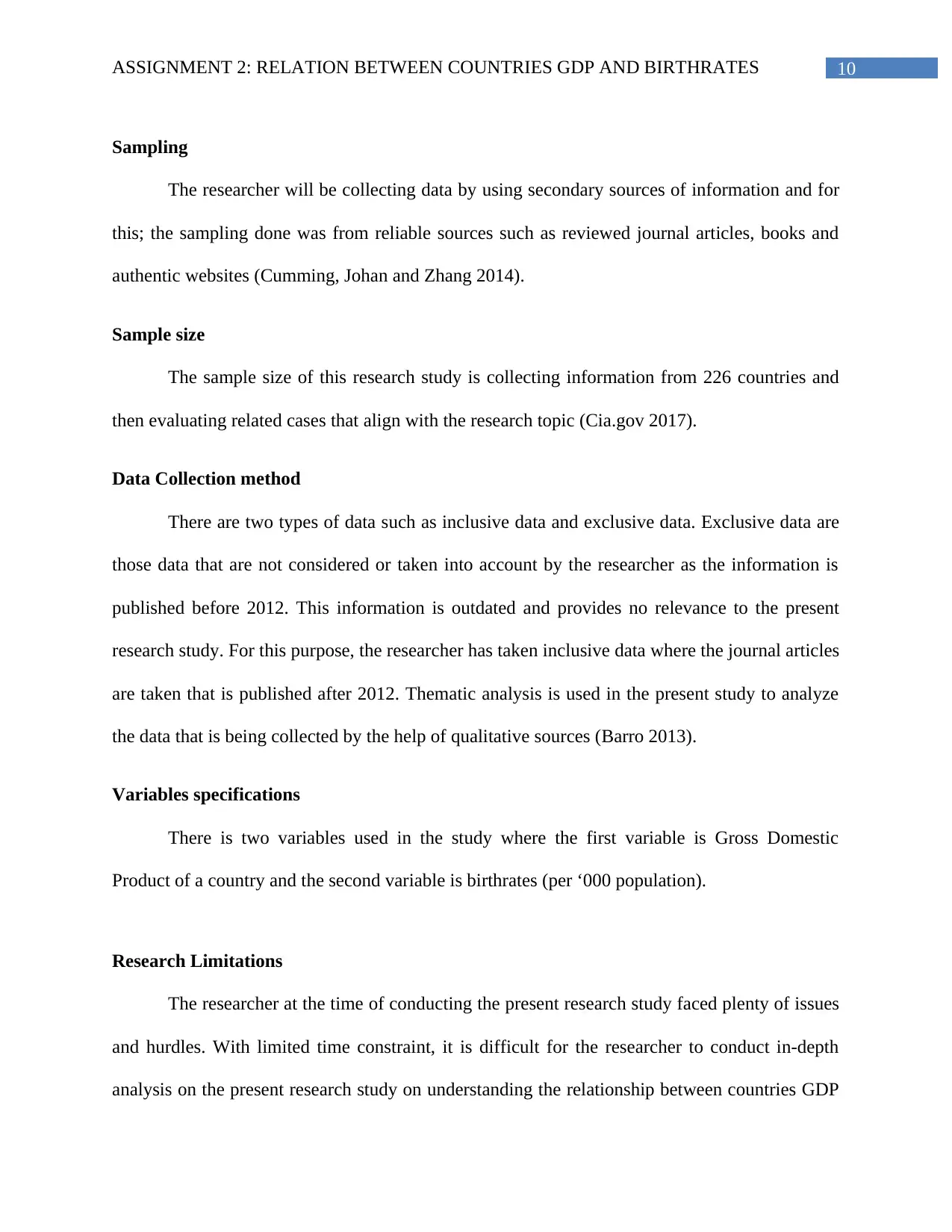
10ASSIGNMENT 2: RELATION BETWEEN COUNTRIES GDP AND BIRTHRATES
Sampling
The researcher will be collecting data by using secondary sources of information and for
this; the sampling done was from reliable sources such as reviewed journal articles, books and
authentic websites (Cumming, Johan and Zhang 2014).
Sample size
The sample size of this research study is collecting information from 226 countries and
then evaluating related cases that align with the research topic (Cia.gov 2017).
Data Collection method
There are two types of data such as inclusive data and exclusive data. Exclusive data are
those data that are not considered or taken into account by the researcher as the information is
published before 2012. This information is outdated and provides no relevance to the present
research study. For this purpose, the researcher has taken inclusive data where the journal articles
are taken that is published after 2012. Thematic analysis is used in the present study to analyze
the data that is being collected by the help of qualitative sources (Barro 2013).
Variables specifications
There is two variables used in the study where the first variable is Gross Domestic
Product of a country and the second variable is birthrates (per ‘000 population).
Research Limitations
The researcher at the time of conducting the present research study faced plenty of issues
and hurdles. With limited time constraint, it is difficult for the researcher to conduct in-depth
analysis on the present research study on understanding the relationship between countries GDP
Sampling
The researcher will be collecting data by using secondary sources of information and for
this; the sampling done was from reliable sources such as reviewed journal articles, books and
authentic websites (Cumming, Johan and Zhang 2014).
Sample size
The sample size of this research study is collecting information from 226 countries and
then evaluating related cases that align with the research topic (Cia.gov 2017).
Data Collection method
There are two types of data such as inclusive data and exclusive data. Exclusive data are
those data that are not considered or taken into account by the researcher as the information is
published before 2012. This information is outdated and provides no relevance to the present
research study. For this purpose, the researcher has taken inclusive data where the journal articles
are taken that is published after 2012. Thematic analysis is used in the present study to analyze
the data that is being collected by the help of qualitative sources (Barro 2013).
Variables specifications
There is two variables used in the study where the first variable is Gross Domestic
Product of a country and the second variable is birthrates (per ‘000 population).
Research Limitations
The researcher at the time of conducting the present research study faced plenty of issues
and hurdles. With limited time constraint, it is difficult for the researcher to conduct in-depth
analysis on the present research study on understanding the relationship between countries GDP
Paraphrase This Document
Need a fresh take? Get an instant paraphrase of this document with our AI Paraphraser
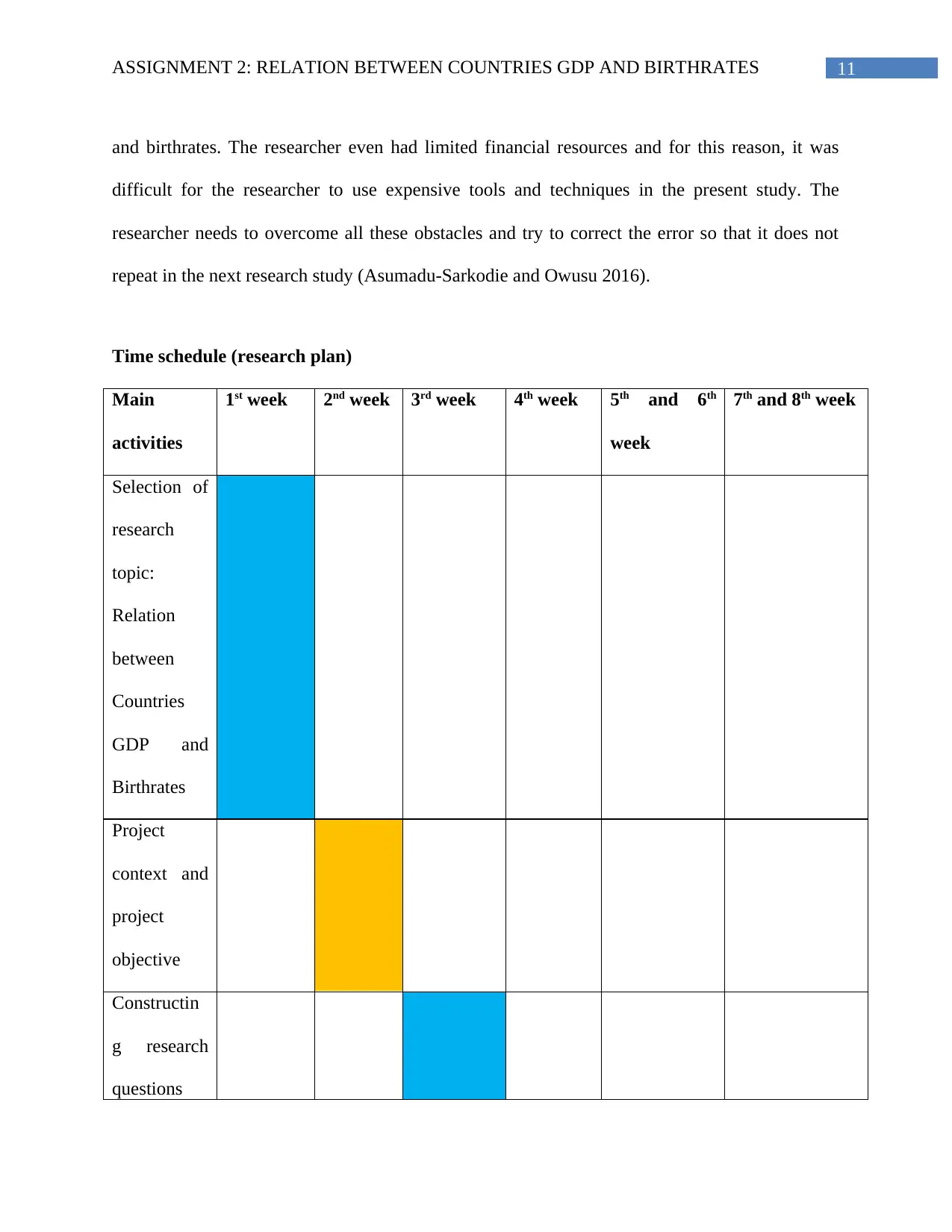
11ASSIGNMENT 2: RELATION BETWEEN COUNTRIES GDP AND BIRTHRATES
and birthrates. The researcher even had limited financial resources and for this reason, it was
difficult for the researcher to use expensive tools and techniques in the present study. The
researcher needs to overcome all these obstacles and try to correct the error so that it does not
repeat in the next research study (Asumadu-Sarkodie and Owusu 2016).
Time schedule (research plan)
Main
activities
1st week 2nd week 3rd week 4th week 5th and 6th
week
7th and 8th week
Selection of
research
topic:
Relation
between
Countries
GDP and
Birthrates
Project
context and
project
objective
Constructin
g research
questions
and birthrates. The researcher even had limited financial resources and for this reason, it was
difficult for the researcher to use expensive tools and techniques in the present study. The
researcher needs to overcome all these obstacles and try to correct the error so that it does not
repeat in the next research study (Asumadu-Sarkodie and Owusu 2016).
Time schedule (research plan)
Main
activities
1st week 2nd week 3rd week 4th week 5th and 6th
week
7th and 8th week
Selection of
research
topic:
Relation
between
Countries
GDP and
Birthrates
Project
context and
project
objective
Constructin
g research
questions
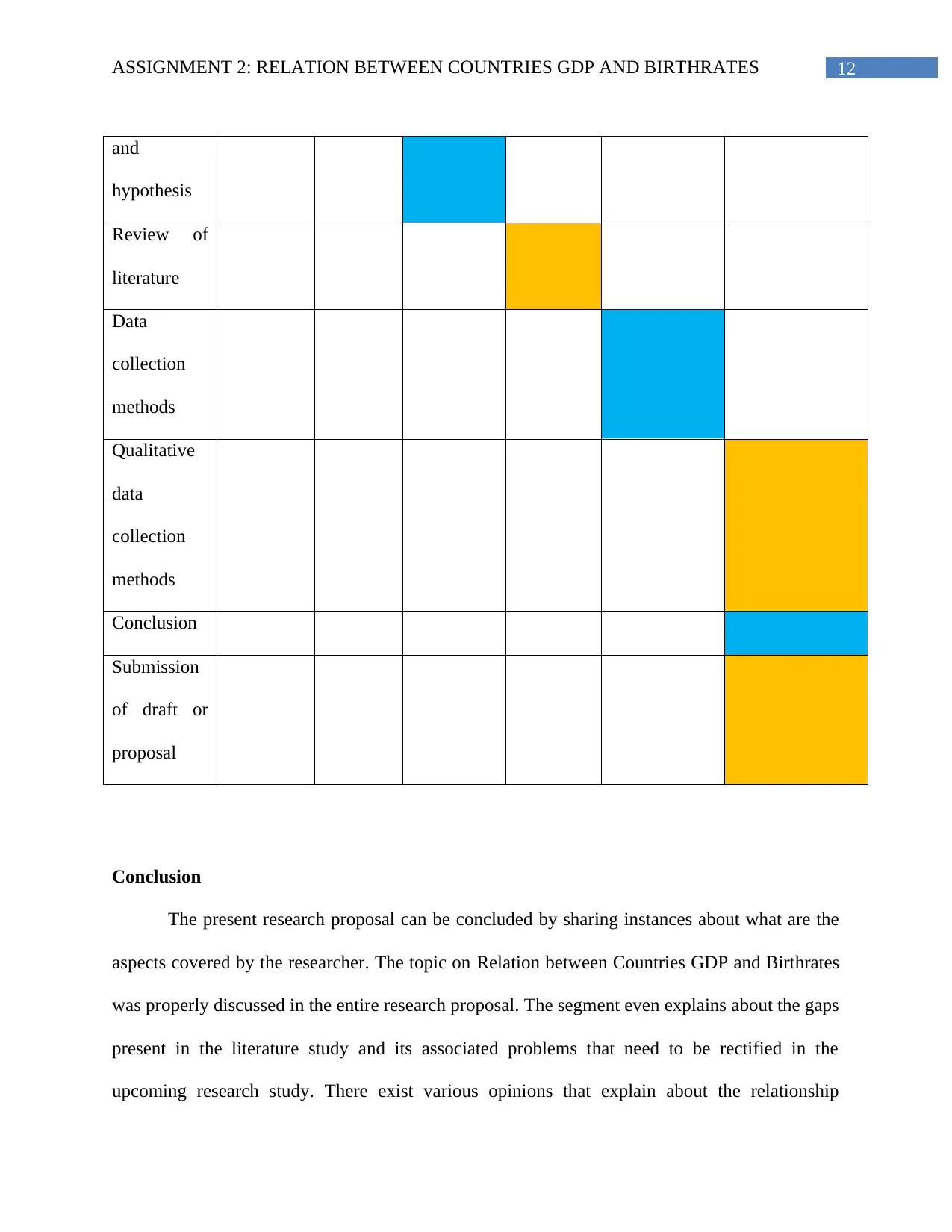
12ASSIGNMENT 2: RELATION BETWEEN COUNTRIES GDP AND BIRTHRATES
and
hypothesis
Review of
literature
Data
collection
methods
Qualitative
data
collection
methods
Conclusion
Submission
of draft or
proposal
Conclusion
The present research proposal can be concluded by sharing instances about what are the
aspects covered by the researcher. The topic on Relation between Countries GDP and Birthrates
was properly discussed in the entire research proposal. The segment even explains about the gaps
present in the literature study and its associated problems that need to be rectified in the
upcoming research study. There exist various opinions that explain about the relationship
and
hypothesis
Review of
literature
Data
collection
methods
Qualitative
data
collection
methods
Conclusion
Submission
of draft or
proposal
Conclusion
The present research proposal can be concluded by sharing instances about what are the
aspects covered by the researcher. The topic on Relation between Countries GDP and Birthrates
was properly discussed in the entire research proposal. The segment even explains about the gaps
present in the literature study and its associated problems that need to be rectified in the
upcoming research study. There exist various opinions that explain about the relationship
⊘ This is a preview!⊘
Do you want full access?
Subscribe today to unlock all pages.

Trusted by 1+ million students worldwide
1 out of 15
Related Documents
Your All-in-One AI-Powered Toolkit for Academic Success.
+13062052269
info@desklib.com
Available 24*7 on WhatsApp / Email
![[object Object]](/_next/static/media/star-bottom.7253800d.svg)
Unlock your academic potential
Copyright © 2020–2025 A2Z Services. All Rights Reserved. Developed and managed by ZUCOL.





